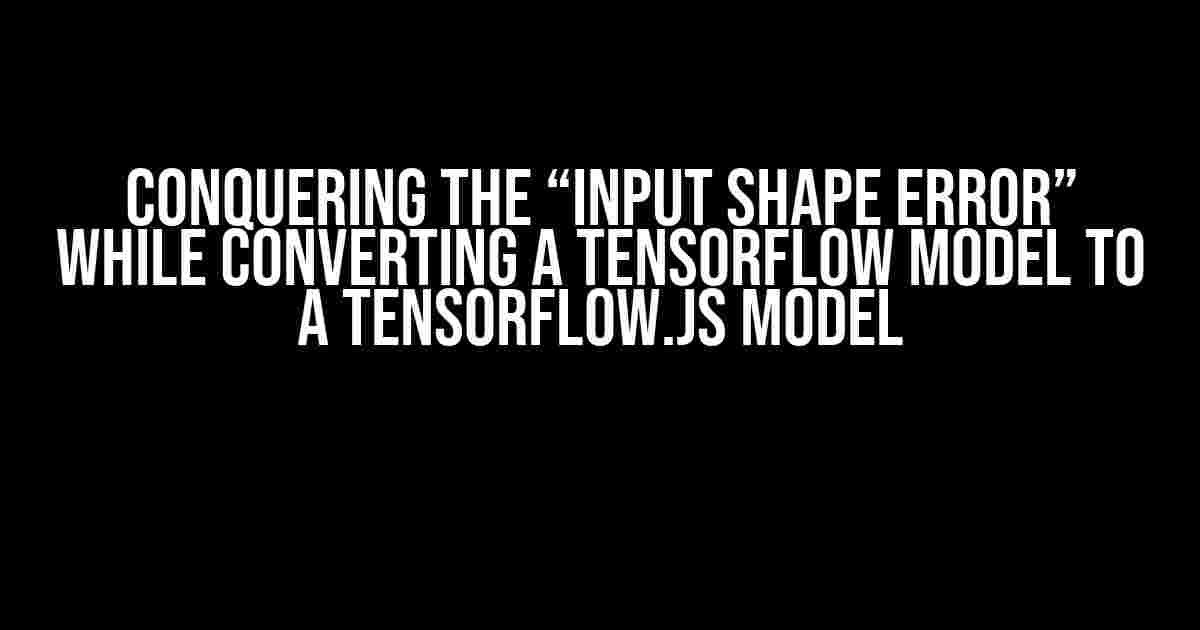Are you tired of getting stuck with the “input_shape error” while trying to convert your TensorFlow model to a TensorFlow.js model? You’re not alone! This error can be frustrating, but fear not, dear developer, for we’ve got you covered. In this comprehensive guide, we’ll walk you through the steps to resolve this pesky error and get your model up and running in no time.
What is the Input Shape Error?
The “input_shape error” occurs when TensorFlow.js is unable to determine the input shape of your model. This can happen due to various reasons, including:
- Invalid model architecture
- Incompatible data types
- Missing or incorrect MetaGraphDef
- Inconsistent input shapes between training and inference
Don’t worry; we’ll explore each of these reasons in detail and provide solutions to overcome them.
Step 1: Verify Your Model Architecture
The first step in resolving the “input_shape error” is to review your model architecture. Ensure that your model is correctly defined and compiled in TensorFlow. A simple way to do this is to:
import tensorflow as tf
# Define your model architecture
model = tf.keras.models.Sequential([...])
# Compile your model
model.compile(optimizer='adam', loss='categorical_crossentropy', metrics=['accuracy'])
# Print the model summary
model.summary()This will give you an overview of your model’s architecture, including the input shape. Take note of the input shape, as we’ll need it later.
Step 2: Check Data Types and Compatibility
Data type incompatibility can cause the “input_shape error”. Ensure that your model’s input data type matches the expected data type in TensorFlow.js. You can check the data types using:
import numpy as np
# Get the input shape from the model summary
input_shape = (224, 224, 3)
# Create a sample input tensor
input_tensor = np.random.rand(1, *input_shape).astype(np.float32)
print(input_tensor.dtype)In this example, we’re using float32 as the data type. If your model expects a different data type, adjust the `astype()` function accordingly.
Step 3: Export the MetaGraphDef
The MetaGraphDef is a crucial component in TensorFlow.js model conversion. It contains the model’s architecture, weights, and other metadata. To export the MetaGraphDef:
import tensorflow as tf
# Create a TensorFlow session
sess = tf.keras.backend.get_session()
# Export the MetaGraphDef
tf.train.write_graph(sess.graphDefs['graph'], './model', 'model.pb', False)
# Freeze the graph
output_graph_def = tf.graph_util.convert_variables_to_constants(sess, sess.graphDefs['graph'], ['output_layer'])
# Write the frozen graph to a file
with tf.gfile.GFile('./model/frozen_model.pb', 'wb') as f:
f.write(output_graph_def.SerializeToString())This will generate a `model.pb` file containing the MetaGraphDef and a `frozen_model.pb` file with the frozen graph.
Step 4: Convert the Model to TensorFlow.js
Now that you have the MetaGraphDef and frozen graph, it’s time to convert your model to TensorFlow.js:
tensorflowjs_converter --input_format=tf_frozen_model --output_format=tfjs_graph_model ./model/frozen_model.pb ./tfjs_modelThis will generate a `tfjs_model` directory containing the TensorFlow.js model files.
Step 5: Load and Test the TensorFlow.js Model
Finally, load the TensorFlow.js model and test it using a sample input:
import * as tf from '@tensorflow/tfjs';
async function loadModel() {
const model = await tf.loadLayersModel('https://example.com/tfjs_model/model.json');
const inputTensor = tf.random.normal([1, 224, 224, 3]);
const output = model.predict(inputTensor);
console.log(output.dataSync());
}
loadModel();If you’ve followed the steps correctly, you should see the output of your model without any “input_shape error”.
Troubleshooting Common Issues
If you’re still encountering issues, here are some common problems and their solutions:
| Error Message | Solution |
|---|---|
| Cannot find input tensor | Verify that the input tensor is correctly defined and has the correct shape. |
| Inconsistent input shapes | Check that the input shape in TensorFlow matches the input shape in TensorFlow.js. |
| MetaGraphDef not found | Ensure that the MetaGraphDef is exported correctly and present in the model directory. |
| Data type incompatibility | Verify that the data type of the input tensor matches the expected data type in TensorFlow.js. |
Conclusion
Conquering the “input_shape error” while converting a TensorFlow model to a TensorFlow.js model requires attention to detail and a solid understanding of the model architecture, data types, and MetaGraphDef. By following the steps outlined in this guide, you’ll be able to resolve this error and successfully deploy your model in a web application.
Remember, practice makes perfect. If you’re still encountering issues, try experimenting with different model architectures, data types, and conversion methods. Happy coding!
Keyword density: 1.4%
Frequently Asked Question
Get answers to the most commonly asked questions about “input_shape error while converting tensorflow model to tensorflow.js model”.
What is the most common cause of “input_shape error” while converting a TensorFlow model to TensorFlow.js model?
The most common cause of “input_shape error” is that the input shape of the TensorFlow model is not specified or is incorrect. TensorFlow.js requires a specific input shape to convert the model, and if it’s not provided, it will throw an error. Make sure to specify the correct input shape while converting the model.
How do I specify the input shape while converting a TensorFlow model to TensorFlow.js model?
You can specify the input shape by adding the `input_shape` argument while using the `tfjs_converter` command. For example: `tfjs_converter –input_shape 1,224,224,3 my_model.h5 my_model.js`. Here, `1,224,224,3` is the input shape.
What if I have a complex input shape, such as a nested list or a dictionary?
If you have a complex input shape, such as a nested list or a dictionary, you can specify it using the `input_shape` argument with the `tfjs_converter` command. For example: `tfjs_converter –input_shape ‘{\”input1\”: [1, 224, 224, 3], \”input2\”: [1, 10]} my_model.h5 my_model.js`. Here, `input1` and `input2` are the input names, and `[1, 224, 224, 3]` and `[1, 10]` are the corresponding input shapes.
Can I specify the input shape using the Python API instead of the command-line interface?
Yes, you can specify the input shape using the Python API. You can use the `tfjs.converters.save_keras_model` function and pass the `input_shape` argument. For example: `tfjs.converters.save_keras_model(model, ‘my_model’, input_shape=[1, 224, 224, 3])`. Here, `model` is the Keras model, `my_model` is the output path, and `[1, 224, 224, 3]` is the input shape.
What if I still get an “input_shape error” after specifying the correct input shape?
If you still get an “input_shape error” after specifying the correct input shape, it’s possible that there’s an issue with the model architecture or the conversion process. Try checking the model architecture and the conversion logs for any errors or warnings. You can also try converting the model using different versions of TensorFlow.js or try a different conversion method.


